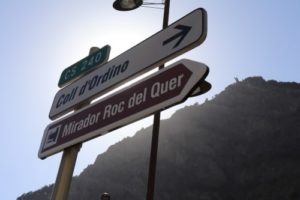Resources
Our Favorite Resources
Book Reviews
Travel Guides
And more….
To help you make your travel dreams a reality!

These travel guides will show you how to travel on a budget through some of the most beautiful places in the world.
May your travels be fun, safe, and full of surprises!
The Simply See The World
Andorra Travel Guide
Table of Contents
- Andorra…where is that place, again?
- How to Get Here
- Where to Stay
- How to Get Around
- What to Do
– Cirque du Soleil – “Rebel”
– Our Week in Andorra
- Tips & Hacks
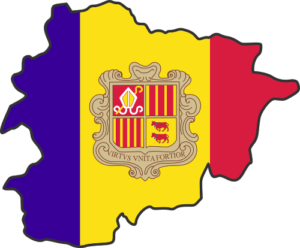
Andorra…where is that place, again?
Andorra is the sixth smallest European country at only 468 km2 (or 290 square miles, about half the size of Indianapolis, Indiana) and a population of only 77,000. It’s SMALL!
The capital and largest city is Andorra La Vella and has a mere 23,000 people, which is where Raychelle and I stayed.
Also, you can’t get here by air or by train. There is one road into Andorra from Spain and one another from France.
Think of this landlocked country as a “land island” separated from the rest of Europe by the tall Pyrenees Mountains and the vast “oceans” of Spanish and French countryside.
How to Get Here
Ok, so Andorra sounds a bit isolated…so how do people get here?
Most by bus, some by car.
There are many buses that run between the international airports and large train stations of northern Spain (especially Barcelona) and southern France, especially the airport in the French city of Toulouse.
Raychelle and I had to travel separately to get here (long story; a whole other blog post for sure!) so we used two different means of transportation.
She flew on a Vueling Airlines flight from the Málaga, Spain to Barcelona then took a small bus into Andorra La Vella via Andorra By Bus (Raychelle praises their great smartphone app!). The bus ride was three hours long, and while the Wi-Fi on the bus was spotty, it did have USB changer ports for every passenger.
I took an AMAZING train from Málaga to Lleida, Spain operated by Renfe. Smooth, quiet, plenty of leg space for my 6’4” frame and we hit a top speed of 302 km/h (187mph)! FAST! These trains, shaped like a giant toothpicks, are worth a try in Europe – highly recommended.
The train had an EU style electrical outlet for each passenger, and you could purchase Wi-Fi, if so desired. From Lleida, I took a small bus by Grup Montmantell, which had five complimentary minutes of Wi-Fi but no charging stations. Don’t be scared by their HORRIBLE website, it’s legit.
Both of our buses arrived to the Estació Nacional d’Autobusos (national bus station), which is just south of city center. We had a house sitting assignment right on La Valira river, close to the start of Avenue Meritxell (that becomes Avenue Carlemany as you walk east of city center); this is a long street with a TON of shops…more on that later.
Where to Stay
This really depends on your goals, budget, and time of year, so lets do some scenarios. There are a LOT of ways to spend a TON of money here, but there are also plenty of options for the budget traveler.
Our Recommendations for Accommodations During the Summer
Andorra is a winter sports Mecca, but don’t let that scare you away from coming here in the summer. Mountain biking and hiking are king during the warmer months. We really enjoyed our time here in July. Like, REALLY loved it!
- Urban: Andorra La Vella (most stuff to do, dining options, great hikes right from town)
- Small Town: La Massana (mountain biking, hiking, chill)
Our Recommendations for Accommodations During the Winter
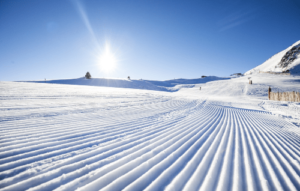
Andorra’s position high in the Pyrenees Mountains makes it a top destination for winter sports enthusiasts.
- Urban: Andorra La Vella
- No ski lifts, but all buses connect to all the lifts from here, and you’re in the big city with the best amenities and close proximity to everywhere in the country.
- Small Towns:
- Pas de la Casa
- If you ARE hitting the slopes, don’t care about vibe, and only care about the most skiing options – – p.s. you might want to speak a bit of French, it’s all we heard being spoken.
- Arinsal
- Great ski town, less slope options, better vibe.
- Canillo
- You can still ski here, but for being so close to Pas de la Casa it doesn’t connect with the slopes there, but it’s a WAY more chillaxable town.
- Pas de la Casa
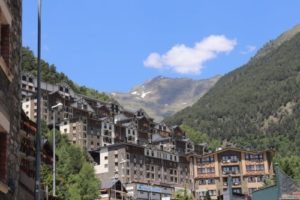
How to Get Around
Walking and taking the bus are the two best options, in our opinion. Everything is in close proximity, so walking is easy; buses can take you virtually everywhere within the country.
Additionally, there are car rental facilities available, but unless you’re going somewhere that buses don’t service we wouldn’t recommend it. Car rentals are expensive in Andorra, we were unable to find any car for under €100. Parking is expensive, too. Only consider getting a car if you plan to go to one of the few places outside of available bus service.
If you’re in Andorra La Vella and don’t want to wait on the bus (or a taxi) or don’t feel like walking, consider renting one of these: an electric stand-up scooter (they’re EVERYWHERE), a bicycle, or a gasoline-powered scooter/motorcycle.
During the summer don’t even mess with taxis, maybe consider them if you’re here in the winter and it’s snowing like mad, but otherwise use the fantastic bus system.
Let’s go for a walk!
Walking, our favorite option in Andorra, is easy and safe. Great walking trails and sidewalks exist within every town, often separated from traffic with metal guardrails. If you are walking between towns, be aware that the roads can get very narrow at times and walkers aren’t allowed in certain tunnels (which we found out the hard way when attempting to walk from Pas de la Casa – walking and biking are NOT allowed in that tunnel).
Road signs: If you’re walking or on a bike look for road signs to let you know if you’re permitted to use a certain stretch of road. Signs outlined in blue indicate you ARE allowed on that stretch of road, signs outlined in red mean you ARE NOT allowed.
Never too bus-y for a bus!
Buses are a close second place for our preferred travel method within Andorra La Vella, and are a safer and faster option to get between towns when the sidewalks ends. In Andorra La Vella, buses run almost constantly and connect all parts of town.
There are lots of great options to connect to surrounding towns, too, and they typically stop hourly or every 30 minutes. Be sure to check the schedules online for the most up-to-date routes and times.
There is a bus system app called Moovit; however, we didn’t find it accurate for the bus system in Andorra, though it was helpful in that we were able to find the closest bus stops.
Bus fare pricing: One person, one-way from Andorra La Vella to Pas de la Casa on the French border is only €6.50. All other fares are cheaper.
What to Do?
Keep reading the section below for our review of Cirque du Soleil “Rebel” we saw while in Andorra — which is ONLY performed in Andorra during the month of July each year. It was AWESOME!
Again, this REALLY depends on the time of year you’re here, but also on your goals and budget.
We were here in July and felt like there were TONS of things to do and see. We like winter sports and will likely come back during the winter next time to experience Andorra in a different (not better, just different) way.
One Week in Andorra – Simply See The World-Style.
Day 1:
Raychelle was here alone for the first day (we traveled separately, long story, another blog). She chose to go get some groceries at Andorra 2000 supermarket and chill at the apartment until I arrived that night.
Weather was awesome and there was great people watching from the balcony, cheap entertainment! She walked down to the National Bus Station to meet me and we walked back to the apartment with bags in tow.
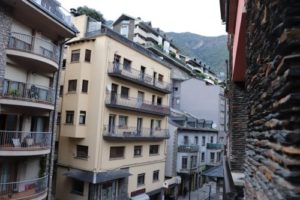
Day 2:
Slept in! Ray and I decided to walk around “Old Town” which has some sightseeing attractions such as La Casa de la Vall (which we never went in, but walked by often) and Seven Poetas Sculptures (which are easily viewed, best at night).
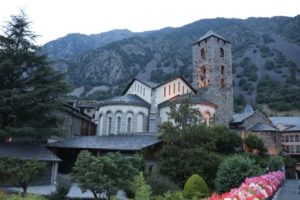
We got some drinks at Barri Antic (hostel and pub), which has an AWESOME vibe, super cute views in the courtyard, and cheap beer.
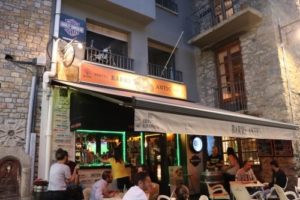
Another highlight, since Raychelle and I are big craft beer fans, was La Birreria De Andorra – several house-brewed beers (stout and IPA were the best) and bottles from around the world.
Day 3:
We began our day with a walk over to Andorra 2000 supermarket, which is a REALLY fun experience. It’s a big store with groceries, produce, and deli, but also has general merchandise and a full-blown clothing section a la department store – it even has a bar and restaurant. Pretty cool place.
€88 later we had groceries and adult beverages for the entire week.
Who wore it better…Andorra 2000 or Andre 3000???
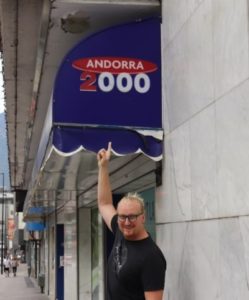
 “Hey ya!!!” – Andre 3000 of Outkast
“Hey ya!!!” – Andre 3000 of Outkast
Cirque du Soleil – “Rebel”
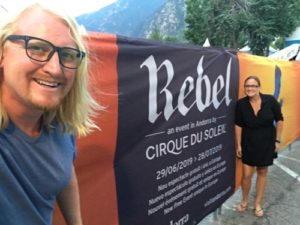
***SPOILER ALERT: This review contains spoilers! Skip ahead to “Day 4” if you don’t want to know what happens in the “Rebel” show.***
Andorra is home to Cirque du Soleil – “Rebel.” It is performed ONLY in Andorra, and ONLY in July of each year. There is a HUGE “tent” (it’s a building, let’s just be real) set up year in a parking lot near Parc Central. Did I mention it was big?
Guess what? Like Raychelle and I, YOU CAN SEE CIRQUE DU SOLEIL “REBEL” FOR FREE!!!
We logged onto https://www.cirquedusoleil.com/rebel and get free tickets, which are parking lot level looking up to the large stage, or tickets for purchase in the bleachers. Raychelle and I were happy with the free, standing-only tickets that placed us stage right about 3 meters (10 feet) from the stage.
NOTE: Get you tickets EARLY, especially if you’re planning on going to a weekend performance. Arrive a bit early to the show if you get free tickets so you can get a good place to stand.
Review of the show:
“Rebel” is a show inspired by the Rock & Roll and has a lot of great songs including Jimi Hendrix “Purple Haze”, Elvis Presley “Heartbreak Hotel”, Bob Dylan “Blowing in the Wind”, George Michael “Faith.” There were several awesome Spanish and French songs, too.
There was a fantastic aerial silk performer, a cyr wheel performer who was also the emcee (my favorite!), a giant swing that performers launched from and then landed in a net, a roller-skating duo who were brilliant, an artistic and incredible pole dancer, and many other performances before the finale.
The Finale:
The finale was motorcycle stunt that had several phases. There was a giant sphere that the riders would enter from a door that would then close to enclose the sphere.
First one rider, then two together…then three. Zooming around in rapid circles, weaving in and out of each other’s paths. Crazy!
Then, we saw a fourth rider approach the outside of the sphere. We we’re like “Turn around, there’s already three riders in there!” but he entered anyways, haha!
So they started riding in circles again, but this time there was a twist: not only were there four riders, the sphere they were riding within came apart and became two hemispheres! We were REALLY nervous – it was a nail biter, for sure!
The riders continued circling in two detached hemispheres and then the separate pieces finally joined together again.
The crowd went CRAZY!!! What an exciting end to a GREAT show.
Raychelle and I have seen Cirque du Soleil “O” in Las Vegas, and we liked “Rebel” much more. Tickets were about $125 for “O”, and they were FREE for “Rebel”.
How about that?!?
Bottom line: If you’re in Andorra in July, you really have to go see “Rebel”.
Day 4:
Another workday in the apartment. Around sunset we took a stroll around town and had some delicious chilled red wine from the Ribeiro region of Spain while playing a game of Phase 10 (our favorite card game) at a great place on the river called Granja Diva.
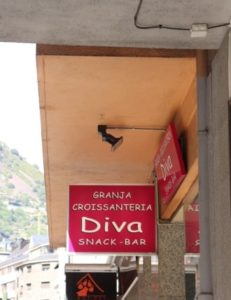 Two wines = €3.90. Yep!
Two wines = €3.90. Yep!
Diva, as it’s called, has a diner vibe and an awesome riverside outdoor dining area, and great service with a smile – try it for breakfast, too!
Day 5:
We thought the people watching was good from our balcony, but oh boy, just wait until you walk through the BRIGHTLY LIT shopping district of Avenue Meritxell!
Here you’ll see travelers from throughout the world shopping until they’re dropping at chain stores and luxury retailers. Raychelle found a specific style of shirt she’s been looking for at Mango for only €12.
Along this avenue you’ll find perfumes, tobacco, booze, electronics, normal stuff, weird stuff…they’ve got it all! If you love shopping, even window-shopping, you’ll love this. If you don’t, still check it out anyways and enjoy the chaos – it’s entertaining.
Plus, the avenue is punctuated by an art installation of giant snails!
Day 6:
Time to get out of the “big” city for a bit and check out some of the smaller towns! We took the L5 bus route to the ski resort town of Arinsal, which was €3.35 per person. The bus takes you straight to the gondola lifts at Ushuaia Mountain Hotel.
Our day turned out to be a mix of hiking and bar hopping.
We started walking back towards Andorra La Vella on the sidewalks (and occasionally the road, sometimes no sidewalk is present when the road narrows) and we stopped at El Cabin. FANTASTIC view! There we enjoyed a delicious Complot Mediterranean IPA.
After enjoying our beers and snacks creek side, and getting an obligatory picture within the gondola car they have converted into being a tiny dining room, we continued downhill back towards the city.
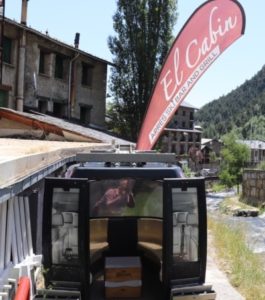
During this point in our trip we used a Pro Travel Tip. Read the “Tips and Hacks” section below to find out more.
As we continued to walk we would occasionally stop in a gas station to use the restroom and grab a drink. Four cans of beer = €1.58
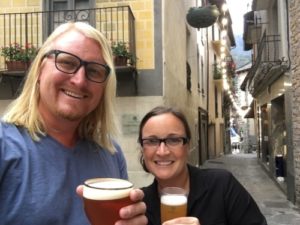
We used another Pro Travel Tip here. More below!
Mountain Biking in Andorra
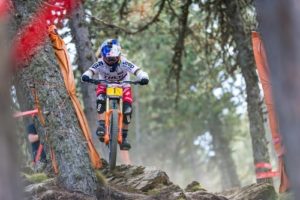
Then we happened upon something pretty cool, the UCI Mountain Bike World Cup, which was taking place in Vallnord (the north end of La Massana). This was really fun to watch!
We noticed the bikers would ride on the road into La Massana after their run, so we walked ahead to figure out where they were going. Turns out there is a gondola lift there and the bikers would ride their bikes into the building, onto the escalator, and then load themselves and their bikes on the gondola for their next run down the mountain. Neat stuff!
There is a walking trail that connects La Massana to Andorra La Vella so we got off the sidewalks/road and enjoyed the tree-lined trail back into the city. You could take this trail the whole way between the two towns, if you so desired – good choice! It follows the creek and is super chill.
We got back to Andorra La Vella and “splurged” on a €30 meal of tasty pizza and empanadas from Lescenari de Pizzes. Recommended.
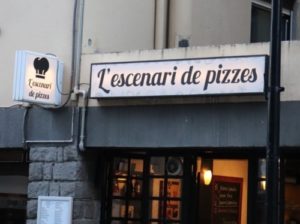
Day 7:
Another day outside of the city, only this time out to the far east of Andorra. Raychelle and I hopped on the L4 bus to Pas de la Casa, which is situated high in the Pyrenees on the French border.
We are REALLY glad we did this side trip! Andorra is MUCH more than just Andorra La Vella, and not getting outside of the city would be a shame.
The bus winded its way up through small towns and finally through a looooooong tunnel, delivering us to a part of Andorra that looks unlike any other part we had seen thus far.
There were no trees and the town looked almost fictional in the context of the craggy, windswept setting. Pas de la Casa is VERY different from Andorra la Vella.
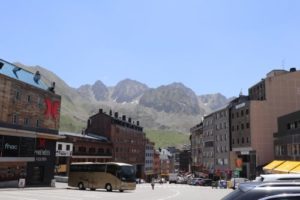
Remember taking French in High School or College? Might be a good time to brush up.
First, we noticed that while we heard nearly everyone speak Spanish in Andorra La Vella, nearly everyone in Pas de la Casa spoke French.
Second, this town was about two things, and two things only…winter sports and shopping. If you don’t like either of those things there won’t be a whole lot here for you besides an interesting landscape.
We got off the bus and walked around. We saw cows grazing underneath the ski lift and people hiking amongst them. Lovers snuggled under the parked gondola cars and restaurant workers courted us to sit at their establishment.
Shop owners chatted with patrons and the shelves were stocked with booze, giant bottles of booze, giant multi-carton packs of cigarettes, and even-more-enormous multi-carton packs of cigarettes with a “free” bottle of booze shrink wrapped to it.
You get the picture.
Stores also sold winter sports gear, hunting and fishing gear, fragrances, bulk-sized laundry detergent, and all sorts of electronics. Andorra has lenient tax laws and has historically been considered a partial tax haven.
So, we think French folks were driving in, stocking up, and heading back home.
After walking around for a bit we bought some drinks and snacks and loaded up our backpack to return to Andorra La Vella by foot.
We started to walk through the long tunnel and shortly after entering we were flagged down by an orange truck with a man dressed in orange whom motioned us to turn around. We did, and we saw that he had parked and was walking towards us. Apparently we did not understand the signs that had a pedestrian and a bicyclist pictured.
“Stop right there!”
In Andorra, if a sign is outlined in blue it means an action or method of transport is permitted, if outlined in red (as was the pedestrian/bicyclist on the sign outside the tunnel) it is NOT permitted. Whoops! Back to the bus stop, for a trip through the tunnel.
We were the only two people on the Greyhound-sized bus through the tunnel and we got off on the first stop: Soldeu. Soldeu and its neighbor El Tarter where both beautiful and quaint.
If you plan to come to Andorra for winter sports, do consider staying in Soldeu because there are gondola lifts that connect to Pas de la Casa. We feel that Pas de la Casa is home to the best skiing options, but is odd, utilitarian, and geographically isolated. The Soldeu-Pas de la Casa ski gondola system connects over 10% of Andorra’s landmass (that’s big!) and offers both downhill and cross-country skiing.
Take a hike!
We found a trail connecting Soldeu to Canillo. They are renovating it currently and set to install a new walking bridge. Very pretty hike. However, there was a detour and we had to turn around. Maybe it will be ready for when you visit Andorra 🙂
On the road walking to Canillo we enjoyed beautiful mountain vistas and small pockets of development. If you’re a rock climber, consider looking into a curious man-made, roadside rock-climbing wall towering above the road called Rocòdrom Canillo.
A couple other sights to see in this area are Sant Joan de Caselles Church and Museu de les Dues Rodes (M2R), the Museum of Two Wheels. We didn’t do either, but if you love old churches and traditional Andorran architecture Sant Joan will surely please.
Traveling simply means NOT doing everything, because doing EVERYTHING is exhausting, expensive, and unrewarding.
I LOVE motorcycles and would have enjoyed M2R, but when traveling simply you just can’t do EVERYTHING – and that’s ok. We will DEFINITELY be back in Andorra sometime – maybe then!
We then entered Canillo, which would be our choice of town to spend time in on the east side of Andorra. Very beautiful and chill vibe, plenty of restaurants, lots of hiking options and a gondola right in town.
For a RIDICULOUS view of the valley, check out Mirador Roc Del Quer. This man-made platform provides amazing views of the valley and surrounding mountains, and has a design essence and feel of the viewing platform of the North Rim of the Grand Canyon, albeit smaller. We were on foot so we just observed from the valley floor below but loved the pictures we saw online.
One more mountain to go!
Finally, we entered En Camp, which is the first small town outside of Andorra La Vella. We didn’t spend much time here but it is very picturesque and the proximity to the city renders it a strategic place to stay/explore. It connects via several buses.
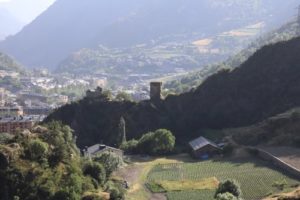
When entering Andorra La Vella from this direction (the east) you will enter through Les Escaldes. We really liked this artsy and humble part of town and will spend some time here next time we go to Andorra.
As a Hoosier, a person from the state of Indiana within the United States, I was excited to see a watering hole called Pub Indiana – which, didn’t seem to have anything to do with my home state, but was fun to see, nonetheless.
Tips & Hacks
- Pro Travel Tip: Two beers and an order of fries is our “cheap-o” travel meal of choice. Gives you just enough time to log onto the Wi-Fi, use the restroom, or just take a small break while only spending a few We have found that often a side of fries ordered a la carte is a fairly big helping, too.
Simple meal. Good deal. Dollars saved = more time/options on the road.
Plus, every single order of fries/chips/frites we’ve had in Europe has been REALLY good!
- Pro Travel Tip: Gas stations are often excellent places to save money on the road. For example, in Andorra we stopped in to use VERY clean restrooms, fill up our water in the sink (if the restroom is clean then it’s not gross to fill your water bottle, get over yourself) (or just buy a cheap water), buy a snack/drink and be on your way.
Travel Tip from Becky with the Good Hair:
- Pro Travel Tip: My sister, Becky is a traveling nurse and is AWESOME at traveling – total pro. She has car camped in her VW Jetta above the Artic Circle in Alaska and backpacked across Southeast Asia.
While on the road, she recommends taking “sinkies” when necessary, which are fully/mostly clothed sponge baths (sink baths). To be clear, still bathe in traditional way – she/we are NOT recommending you give up showers.
However, if you’re sweaty and gross, in the middle of nowhere, or camping, it is a solid option. A gas station with a locking bathroom door can offer you a way to freshen up in a pinch.
I enjoyed a “sinkie” in Canillo as a way to cool down. Thanks, Shell gas station!
Be sure to check out our Instagram and YouTube channel for pics and videos from our trip!!!
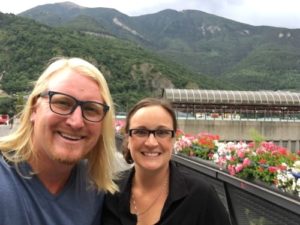
The Simply See The World
Northern Spain Travel Guide
Visiting Northern Spain had been a dream of ours for a long time- and in fact, is what inspired us to start traveling the world in the first place. It was a part of the world that intrigued us in more ways the one: natural beauty, food, people, culture – just to name a few. The trick was figuring out how to do everything we wanted – on a budget!
Keep reading to learn where to go, what to see, and which food to eat without breaking the bank!
Santander
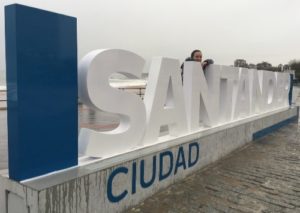
RAIN! RAIN! RAIN!!!
We arrived in Santander on November 1st and we didn’t have more than three consecutive hours of sunshine until November 19th.
It was wet.
However, we did manage to get out and enjoy Santander, especially once the weather lifted.
And we loved it! Here’s the skinny:
Where We Stayed
Airbnb is a fun place to hunt for deals. Sometimes you can get a better deal on weekdays vs. weekends and other times a weekly discount can wow you. For us, it was a monthly rate that knocked our socks off.
To learn more Airbnb tricks – Check this out! Top 5 Airbnb Tips and Hacks – Webisode 3!
We found a MONTH long rental in the family-friendly, yet hip neighborhood of Puertochico.
Cost: $600 USD, or $20 per night.
Nice!
Our unit was simple with a kitchen and semi-separated bedroom with a bathroom, but it served our needs perfectly.
Spain is Totally Our Jam, Man!
You probably already know that we LOOOOOOOOVE Spain if you follow us on Instagram or Pinterest, read our blogs, or watch our YouTube Channel.
In fact, we considered immigrating to Spain in our initial travel plans, but decided to travel the world instead. There is a very long story to share about this decision, but that’s a whole other blog entirely!
Our First Two Weeks in Santander
Weather.com called it an “Atlantic Disturbance” – we just called it WET!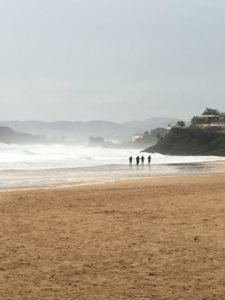
Even locals were bummed with the weather our first two weeks, but we found ways to explore in spite of Mother Nature.
The beaches here are really nice, even in the fall, and the surfing community is very active.
We totally suggest walking over to Playa Piquío to watch the surfers – especially on days with rough seas! When we were there the police had closed a sidewalk along Ave. Manuel García Lago (north side of the beach) because the waves were crashing up onto the walkway. Pedestrians were forbidden to pass, but if you had a surfboard in your hand you were good to go!
We watched the surfers wait for the wave to crash, then jump into the water – board in hand – from the walkway, landing on the backside of the wave.
These guys were bold – and a little crazy!
What To Do In Santander
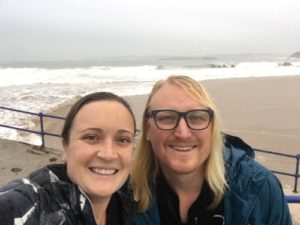
This depends on the time of year that you come. Summer time: you’ll likely be catching some rays on the beach…
But…
If you come in the Autumn (like we did) or the winter, and you left your wetsuit at home, here are some ideas:
1. Take a Stroll
Santander is a great place for a leisurely paseo that is punctuated by tapas and beverages.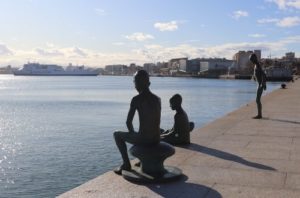
The bay was one of our favorite areas to walk around and explore.
Let me set the scene: The mountains surrounding the bay are covered in gorgeous snow and the air is clean and brisk, but an ambitious swimmer glides past us just a few meters from the concrete walkway.
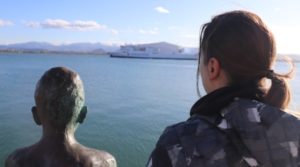 A group of ladies struggle to get just the right selfie, so Raychelle walks over to assist. After a mini photo shoot we too take a few of our own – it’s a gorgeous day. Here the Los Raqueros statues are posed as if they too will join the swimmer from earlier and dive into the chilly harbor.
A group of ladies struggle to get just the right selfie, so Raychelle walks over to assist. After a mini photo shoot we too take a few of our own – it’s a gorgeous day. Here the Los Raqueros statues are posed as if they too will join the swimmer from earlier and dive into the chilly harbor.
The architecture of the Santander Bank building – complete with pass thru archway – is beautifully juxtaposed against the stunning and ultra-modern Centro Botín.
This part of town is all about people watching, shopping, and tapas.
2. I’m on a Boat!
Boy, are we suckers for a boat ride! Santander has a ferry company called Los Reginas that services points throughout the bay that caters to tourists and commuters alike. 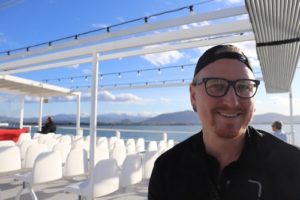
We took a ride that went southeast across the bay making stops at Pedreña and Somo. The boat was two stories with an enclosed water-level story and an open-air top deck. We sat up top (of course), so we could easily view the snow covered peaks surrounding Santander, and enjoy the 50 minute round trip.
It was fun and really cheap. €10 for both of us.
If you want an inexpensive way to get a beautiful skyline view and just be out on the water – this the way to do it!
3. Overlook from Centro Botín
The Centro Botín is a beautiful modern museum located in the heart of the city. We didn’t go into the museum, but on top of it is one of the best views of the city with a great view of the skyline and the harbor. When you get to the museum, you will see stairs and an elevator. Take either one to the top and take in the gorgeous view. Don’t forget your camera.
Oh, and did I mention it’s FREE? 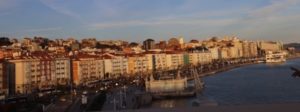
4. Eat, and Drink
Food and drink is a big part of the adventure when we travel to a new place. We love trying it all and in Santander we found the tapas to be simple, cheap (often a small one free with a drink), and delicious.
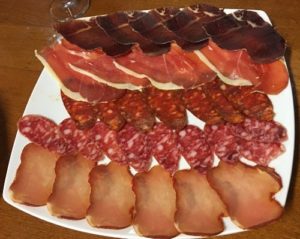 Favorites: Anything on top of a small piece of bread! Jamón is popular, and definitely worth trying. We were surprised by how
Favorites: Anything on top of a small piece of bread! Jamón is popular, and definitely worth trying. We were surprised by how 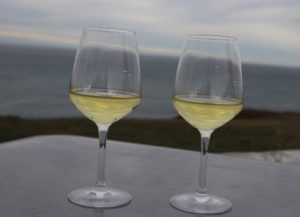 much we liked bacalao (cod) that takes many forms – our favorite being a delicious spreadable paste on, you guessed it, bread.
much we liked bacalao (cod) that takes many forms – our favorite being a delicious spreadable paste on, you guessed it, bread.
Try the white wines of Cantabria and the surrounding areas. Crisp, fantastic minerality, and just a touch of butteriness. Think – a tame New Zealand Sauvignon Blanc meets a Chardonnay.
The Spanish love their wine, but beer is ubiquitous. We tend to like Alhambra the best of the light beers, but prefer Estrella Galicia, if available. Or go to SMACH Brewing for the tastiest craft beer in Santander!
Brewery Alert!
Craft beer is one of our favorite things and Spain has virtually ZERO craft breweries.
Operative word…virtually.
Whenever we travel we always do a Google Maps search for “breweries”, “wineries”, and “distilleries” in the surrounding areas. We enjoy visiting these establishments because, well, it’s fun (duh!) and it’s a great way to understand a given culture’s spin on fermented beverages and more often than not we find ourselves steeped in history and culture, too.
Pun intended!
Santander’s first and only craft brewery is called SMACH Fábrica de Cerveza, or simply “SMACH”. It’s pronounced just like that song from 2006 by Akon… “Smack That”
‘memba dat?!?
Where is it…
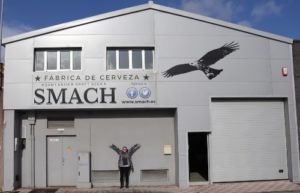 Hidden in an industrial park just on the other side of Santander Airport’s fence, SMACH could easily be passed by if it weren’t for its sign. It looks like a warehouse from the outside, but once you enter you’ll see the vats used in the brewing process. Interestingly, you’ll also see stadium style seating made of wood – bleachers for events that take place in the brewery.
Hidden in an industrial park just on the other side of Santander Airport’s fence, SMACH could easily be passed by if it weren’t for its sign. It looks like a warehouse from the outside, but once you enter you’ll see the vats used in the brewing process. Interestingly, you’ll also see stadium style seating made of wood – bleachers for events that take place in the brewery.
The space is clean and skylights illuminate the room. On rainy days (common in Santander) the roof provides a relaxing soundtrack, too.
For only €5 per person at SMACH, you’ll get a full brewery tour and 4 unique half-bottle pours, which showcase the four beers currently in production. We liked the Smach IPA and the Double SMACH best as both were very balanced with lightly to semi-aggressive hop undertones. The other two offerings, a brown ale and a pale ale were very tasty as well.
Who owns it….
Luis Giménez Escalante is the owner and head brewer of SMACH and was happy to answer our questions. He discussed his passion for craft beer and his desire to share those flavors with the Spanish public. 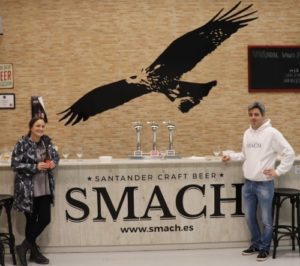
Just as in the United States before the Craft Beer Revolution (circa 1999 – today), in Spain today there are just a few major players in the market.
Throughout the country, you’ll see ubiquitous brands such as San Miguel, Estrella, Mahou, Cruzcampo, and Alhambra in supermarkets and in bars throughout Spain.
These brands dominate the market and would be akin to the pervasiveness of Bud Light, Miller Lite, and Coors Light in the US market twenty years ago.
Craft beer represents less than 1% of total beer sales in Spain today; however, with double digit annual growth it seems as though Spaniards are excited to rediscover beer. Great beer.
Luis faces the challenges of educating the city of Santander about craft beer, and he is competing for space in a market dominated by Spanish beer giants. We think that his optimism, tenacity, and passion for beer will continue to bring him success and that SMACH will really take off in the coming years!
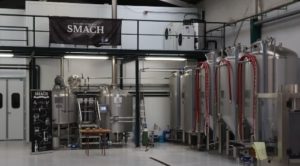 Pro Tip: SMACH is right beside the airport! If you’re flying in or out of Santander consider hitting the brewery as your first or (and!) last stop in town. Just be sure to check the website for the somewhat limited hours of operation.
Pro Tip: SMACH is right beside the airport! If you’re flying in or out of Santander consider hitting the brewery as your first or (and!) last stop in town. Just be sure to check the website for the somewhat limited hours of operation.
To learn more about SMACH and schedule your tasting tour check out their website
Don’t have time for a tour? No sweat! SMACH sells bottles by the case at great prices – why not stock up the fridge in your hotel or Airbnb!?!
Our Favorite Restaurants and Bars in Santander:
-
Bar Tapas 53
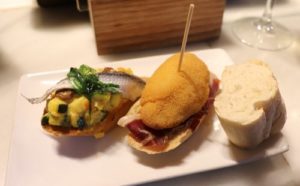
This bar happened to be very close to our Airbnb, but we would have walked to come here. It was our favorite place with a fun vibe, indoor and outdoor seating, and a lot of great people watching. For €1.60/glass, they also happened to serve our favorite cheap red wine in the city.
-
Taxco Tacos y Chelas
After traveling for several months with no Mexican food we were excited for this! We tried the quesadillas and they were very good. The bartender was also super sweet and didn’t kick us out when we came in the door soaking wet from the downpour outside and sat dripping at the bar.
-
Bar Popi
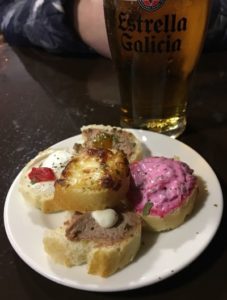
A good-ole-boys joint where the bartender just starts pouring a drink as soon as he sees a regular walk through the door – a tight bunch, but don’t worry, you’ll feel welcome. The only challenge is getting there during their weird and very limited hours! Potato chips and something deep fried is served with every drink.
We ordered a white wine and a delicious vermouth for €2.28 and some complimentary snacks. Fantastic people watching!
-
Bodega San Fermin
Want a hole in the wall full of locals? This is it. Football WILL be on the tv and everyone WILL be drinking a “secret” house wine that is €0.85 and is delicious. We had to ask about what everyone was drinking though, because if you are from out of town you don’t get the house wine.
-
Quebec
We’re partial to the Puertochico neighborhood, but if you want to check out downtown Santander where all the name brand shopping stores line the street, we recommend this restaurant, and no, it’s not Canadian-themed at all.
I had an AWESOME Spanish tortilla (basically an upside down quiche with no pie crust and filled with gooey scalloped potatoes), but this one had an ingredient I had been REALLY excited to try: baby eels (angulas).
While they look like something you don’t want to eat, they are very tasty. There are also other less adventurous, yet equally tasty offerings to be had.
-
Bar Restaurante La Nuncia
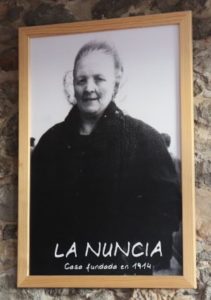 Looking to get some fresh air? Take a walk (it’s a really pretty stroll), bicycle ride, or a scenic drive just moments north of Santander to the La Pereda neighborhood where you’ll find Bar Restaurante La Nuncia.
Looking to get some fresh air? Take a walk (it’s a really pretty stroll), bicycle ride, or a scenic drive just moments north of Santander to the La Pereda neighborhood where you’ll find Bar Restaurante La Nuncia.
Known simply as La Nuncia, you’ll see pictures of the owner’s abuela who opened the place in 1914.
Not only is the bar over 100 years old, so is the recipe for the house vermouth which is poured from a wooden cask. Deeeeelicious! Also, our ham, bacon, and egg sandwich was on point. Great place to enjoy a drink and a bite, chat with the locals, and have a cool view of the city and the sea.
-
Bodegas Puertochio
The WiFi went out in our apartment one morning and we needed to get some work done, so we wandered downtown. Lucky for us, we ended up finding one of our favorite places. It’s a great place for a nice lunch or dinner or just a cup of coffee. We had coffee, tapas, and the owner let us try a delicious soup (on the house). If you are downtown, this is a good place to stop in and relax for a bit.
Bilbao
In order to get to Santander, we flew into Bilbao, but we missed the last bus of the day going to Santander (where our Airbnb was located) because our flight was delayed.
Bummer!
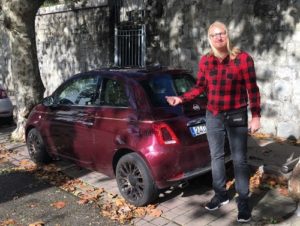 But, something fun happened as a result. We got to rent a Fiat 500! I have an unhealthy obsession with tiny cars and this sweet little piece of metal (and plastic!) made me smile wide.
But, something fun happened as a result. We got to rent a Fiat 500! I have an unhealthy obsession with tiny cars and this sweet little piece of metal (and plastic!) made me smile wide.
The car rental allowed us to get to Santander and drop our stuff off at the AirBnb, but a couple days later we took the little car back to the airport at Bilbao.
Pro Tip: Parking in Santander is a nightmare. We spent way more of our life than we want to admit, driving around looking for parking within a 2 mile radius of our Airbnb. Santander is very walkable and the public transportation is really good, so don’t rent a car unless you REALLY need one!
Wandering Around
–Which in our opinion is a great way to experience a city.
So, since we were already in Bilbao returning our car, we decided to spend a day exploring. From the Bilbao Airport (Bilboko Aireportua) it was a short 20 minute bus ride to downtown and the bus ride ended at the terminal by San Mamés Stadium.
Getting some pictures along the river in front of the Guggenheim is virtually mandatory, so we knew we would eventually end up there later in the day. However, we didn’t do much research besides that.
So we picked a street to walk along to examine a cross section of Bilbao. Our route was roughly a straight line through the city from San Mamés Stadium to Palacio de Deportes Bilbao Arena.
As we walked, we went through several nodes of diversity. A typically Spanish area, an area with predominantly Asian residents, a neighborhood with an African majority, and finally ended up in an area dominated by hipsters.
Brewery Alert!
One of our favorite travel blogs is Vagabrothers. Alex and Marko are charismatic brothers who travel the world and make beautiful films of their adventures.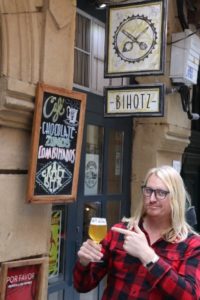
We were always interested in Spain, and Northern Spain, specifically. However, after watching their series about the Basque Country and other regions of Northern Spain we were captivated by the region.
The Vagabrothers stopped at a brewery in Bilbao while they visited, so we too decided to look it up and offer up a “cheers” to them for inspiring us. The establishment is called Café Bihotz. Their beers are delicious and varied including IPAs, stouts, and even some sour beers.
Beer was the only thing on the menu for us, but we saw some awesome coffees and food coming out of the kitchen, too. If you like craft beer, it is worth a stop and a pint.
Stopping for an occasional coffee, beer, or tapas along the way we made it to the Palacio de Deportes Bilbao Arena and decided to make our way to the really nice walkway along the Estuary.
River Walk
Bilbao has an awesome walkway along its estuary. The estuary is more like a river and it feels like a river walk. There are a lot of places to grab some pintxos or drinks while you leisurely stroll. The walking path is full of benches where you can sit and relax, statues and monuments to look at, and beautiful old buildings on either side.
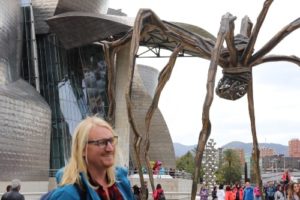 Soon we saw the handsome Puente de La Salve bridge and the Guggenheim positioned at its base. These structures are very interesting and are worth a visit to see. We didn’t go inside due to time constraints, but entrance is €13 if you’re so inclined.
Soon we saw the handsome Puente de La Salve bridge and the Guggenheim positioned at its base. These structures are very interesting and are worth a visit to see. We didn’t go inside due to time constraints, but entrance is €13 if you’re so inclined.
Next we walked back towards the bus station, but opted to go back in towards city center rather than continuing along the estuary.
And I’m glad we did! Sometimes during travel you have a fantastic culinary experience that is totally unexpected. Plaza Campuzano tavern was such a place.
There could be many other establishments in Bilbao that put out such great offerings, not sure, but regardless, we found one!
Tapas for days!
We enjoyed several delicious tapas and chatted with the bartender. Raychelle speaks Spanish pretty well so we were able to have a fairly in depth conversation with him about the food, growing up in Bilbao, and his love of football (soccer)!
Everything from anchovies, to octopus, to patê, briny olives, delicious wines, and great conversation were enjoyed. 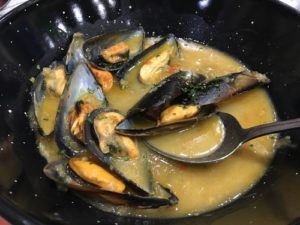
Towards the last few bites of food our bartender said “Have you ever tried a Kalimotxo?”. We both looked at each other and asked him to repeat this curious word. He proceeded to say it slowly, write it down and explain it.
Equal parts red wine and Coca-Cola!
We were concerned – sounded crazy! But, weirdly, it was very tasty.
Great experience! €11.35 out the door – now that’s cheap fun!
Gijón
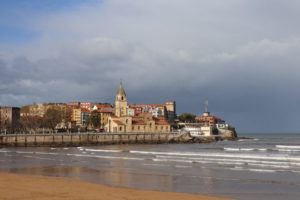
Asturias has been called the natural paradise of Spain and I can see the logic behind that claim. Even within the city limits of Gijón, the waves beautifully lap against the shore with the misty mountains to the south. We enjoyed brief periods of full sun between rain clouds, but had a blast.
Our friend Steve, from back home in the United States, joined us for a weekend in Gijón. We got an Airbnb on the east side of the Gijón Centro neighborhood and were primed for a weekend of enjoying this small but wonderful city.
It was really interesting visiting Gijón after spending two weeks in Santander. There are similarities and differences, like both cities have a harbor, but only Santander has a bay. Santander has a park and a palace on their peninsula, whereas in Gijón, the Cimavilla neighborhood houses lots of hipster hangs and cider joints.
Spanish Cider
Speaking of cider, this is a HUGE difference. In Santander, you can get cider from a supermarket and likely if you ask for it at a bar, but in Asturias cider is a RELIGION!
Ok, so what is cider and why’s it such a big deal?
Cider is made from apples – apple cider – and it’s not like what you get from the store. First, it’s alcoholic and most ciders I saw here were in the 4.5% – 5.5% range. Second, it’s 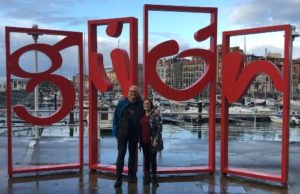 tart, not sweet, with a bit of funk to it. If you’re familiar with sour beers – beers that are funky due to the use of wild yeast strains or bacteria in the brewing process – you’ll notice some, not all, but some of the ciders have this funk. Some people (like Raychelle and I) like this, others don’t. Most ciders, however, are just tart…and delicious.
tart, not sweet, with a bit of funk to it. If you’re familiar with sour beers – beers that are funky due to the use of wild yeast strains or bacteria in the brewing process – you’ll notice some, not all, but some of the ciders have this funk. Some people (like Raychelle and I) like this, others don’t. Most ciders, however, are just tart…and delicious.
Pouring the cider properly is an art, developed over lots of years and practice. We saw many serious-looking servers lift cider bottles high above their head, pour the cider (without looking) into a glass held at their knees. It was pretty incredible – and in fact does make the cider taste better. The basic concept here is the higher the pour, the more air is introduced into the cider, thus enhancing the flavor. Some places have containers to catch the splatter of cider, others just have really sticky floors.
Burgos
Sadly, we said goodbye to our month long Airbnb in Santander and hopped on an ALSA bus down to Burgos. The bus was comfortable, modern with free WiFi and room for personal items overhead. Windy hilly rides made the ride a bit slow, but it was gorgeous as we traversed the coastal mountains on the way to Burgos.
Some of the towns we passed through looked really old, having several multi-family homes clustered around a Catholic church with a tall steeple. Each town had a small restaurant or bar, but not much else.
We saw the lush, green, mountainous landscape laden with tall trees turn to hilly land with mesas, craggy rocks, and scrubby short vegetation. Agriculture happens in both domains but the look is totally different.
The bus station in Burgos is located just south of the city center, and is only a 10 minute walk to Burgos Cathedral and the Plaza Mayor.
Rain Again…
We arrived on a (wait for it……..) rainy Saturday in late November. Walking north to the Plaza Mayor to grab a drink before we could check into our Airbnb, we followed our ears to what sounded like a party.
Outside of Los Toneles Bar Parrilla, or ‘Los Toneles’ for short, the locals weren’t letting the rain stop them from having a great time – they were hanging outside of the bar playing classical acoustic guitars, singing local songs, and gathering quite the crowd. 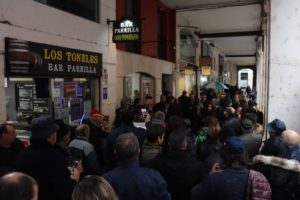
The impromptu concert lasted about a half hour after we arrived and we were loving the energy.
They weren’t playing for money, but were just having fun and bar hopping and avoiding the rain. Seeing this, we knew our time in Burgos would be fun!
The Streets Were Packed!
After walking to our Airbnb located by the Castle of Burgos to drop our bags, we headed back out looking for some tapas and drinks.
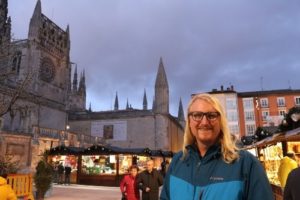
We found plenty of both and the streets were crowded!
A Christmas Market was set up in the shadow of the Cathedral and vino caliente (mulled wine, or warmed wine flavored with cinnamon sticks) was available for €1.50.
Yep, we’ll take a couple of those!
Wandering the streets we stopped in a ton of great places – there are so many to choose from.
-
Restaurante Meson Los Herrero
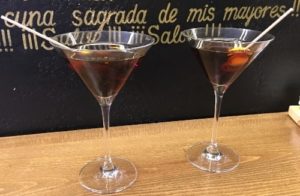
There isn’t a lot I can say about this place because you just HAVE to go! The street it’s on (as well as the next 2 recommendations) is a little tricky to find as it’s just a little alley off of the main plaza, but trying to find it will be worth it – trust me. La morcilla de Burgos (blood sausage with rice on a piece of bread and topped with a fried egg), a local pintxo, was fantastic here as well as all of the other tapas. Pricing was extremely reasonable for both food and drinks.
-
Casa Pancho
……is located across the alley from Restaurante Meson Los Herreros. They are both pretty similar with a few variations – you will have to try them both to pick your favorite.
-
El Pez de San Lorenzo
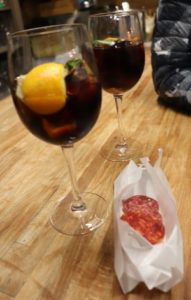
If you want excellent vermouth go here, and as icing on the cake.. it is located just up the street from the two tapas places listed above. Sounds like a night of fun if you ask me! The vermouth here is a secret recipe that the bartender would not give up. They bottle their vermouth – so if you love it like we did, you can buy a bottle to take home. Some light grocery offerings – including delicious cured meats and cheeses – are available to purchase to eat there or later.
-
Vermutería Victoria
Our second favorite homemade vermouth can be found here. They serve their vermouth with an olive and they have a great selection of tapas. It is located just off the cathedral plaza, so after some sight-seeing, Christmas market shopping, or people watching – stopping here is a great idea.
-
Cervecería Morito
Ready for something more than tapas? This place has delicious food and an awesome staff. Keep in mind it is Cash only and they have limited hours.
Burgos is more than just tapas and drinks
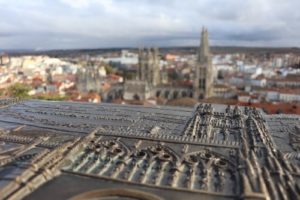 If you are looking for a great view of the city, the walk up to and around the Castle (Castillo de Burgos) is definitely worth it. It is FREE to enter and you have a birds-eye view of the entire city and if you are into history, there are remains here that are over 1000 years old.
If you are looking for a great view of the city, the walk up to and around the Castle (Castillo de Burgos) is definitely worth it. It is FREE to enter and you have a birds-eye view of the entire city and if you are into history, there are remains here that are over 1000 years old.
The Cathedral is also extremely beautiful. We didn’t go inside, but tours are available if it is something you are interested in doing.
Finally, if you are looking for a nice stroll, there is a tree-lined path that follows Río Arlanzón around the old city. Grab an ice cream or a coffee and just enjoy the beautiful city.
San Sebastián-Donostia
It was Beckoning – we heeded the call! Just so happens, we saved the best for last.
There is a place in the far north of Spain that is magical. It’s known as San Sebastián in Castilian Spanish, or Donostia in its native tongue of Euskara (or Basque).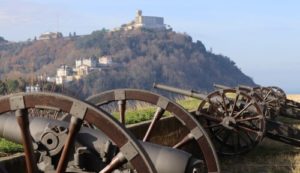
The bus ride from Burgos to San Sebastián was smooth and comfy.
We stopped at various cities on the way up and it was interesting to see the vegetation and weather change on the way north from the dry scrubby interior to the lush green coast.
Once out of the bus station, the River Urumea separates the east and west sides of town. It was early December when we visited and the river was lined with light-draped stalls of a Christmas Market selling local hand-made gifts and treats.
If that doesn’t get you in the holiday spirit, then we don’t know what does!
Let’s Get Out Of Here
After cooping ourselves up in our Airbnb to catch up on some work for a day, we were stir-crazy so we started planning a big day of walking around the city.
We began walking across the bridge to Old Town and continued walking around the peninsula until Monte Urgull and the Mota Castle sat high above us.
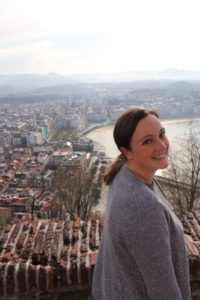 The steep walk up to the top rewards visitors with 360 degree views of the sea, beaches, and city. Be sure to pack some water and a snack.
The steep walk up to the top rewards visitors with 360 degree views of the sea, beaches, and city. Be sure to pack some water and a snack.
During summer months a bar is open and would be a very welcome sight after the climb.
On the way up, you’ll be greeted by cats loudly encouraging you to feed them. (We saw a local couple with a backpack who we assume come up consistently to feed the cats – pretty sweet.)
The Mota Castle has several exhibits and short films to enjoy that discuss the history of the Castle and San Sebastián. Keep walking through the museum until you see the stairs, this takes you out to one of the best overlooks in the city and to the iconic statue of Jesus looking out towards the city.
Wrapping up this fairly athletic climb and descent we were HUNGRY!
Let’s be honest, we came for the food…
Here are our delicious and budget friendly recommendations. Side note: San Sebastián is world renowned for its culinary scene. We stuck with tapas this trip (as we were trying not to spend a ton of money), so none of our recommendations are for the man, many amazing restaurants that fill this city.
-
Bar Roberto
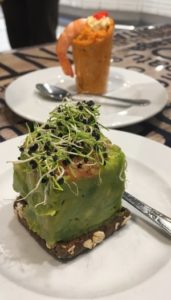
This is definitely a hole-in-the wall that holds about 10 people – making it very cozy. The tapas are pretty basic tapas but the highlight is the yummy vermouth and basque cider. Our bartender was really friendly and let us try some of the local spirits, while making us feel right at home. If you want an authentic Spanish bar vibe – make a quick pit stop here.
-
Nam Restaurante Gros
The lunch prices here are incredible and the food was very good. For $8 we had ham and cheese croquetas, two Spanish omelet variations, morcilla, and a glass of wine each. It also happens to be 2 blocks from the beach, so after you are done filling up, you can stroll and watch the surfers on the beautiful beach front path.
-
Bar Antzara
Again, we needed WiFi, so we wandered in this place and were more than pleasantly surprised. We had a beer each and 3 or 4 tapas $7. The place was busy with the lunch crowd and rightfully so. Food and staff were great.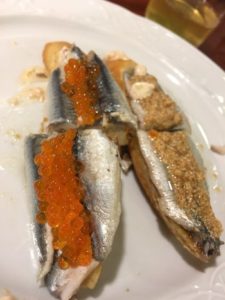
-
Bar Txepetxa
Do you like sardines?? Raychelle didn’t until we tried these. This bar is known for sardine tapas and they were awesome. Be sure to get one with yummy roe! If sardines really aren’t your thing, that’s okay, they have other options – but please at least try it.
I am full, now what?
Walking along the promenade by the large Ferris wheel, we noticed the city really started to come alive. The long coastal path is spectacular with a view of the sea, the castle, the promenade, and the many people just hanging out and enjoying the day.
On the beach, dogs were playing with each other as their humans mingled. A gentleman wrote poetry in the sand using a stick which was easily read from the walkway.
Swimmers glided through the cold water and some beach goers walked ankle-deep in the water on a stroll. Not overly interesting typically – but on this day you could see your breath it was so cold. Quite a tolerance to the cold water – let’s just say we didn’t get in the water!
Getting to the west side of the city we decided on another tapas break before heading back.
Strolling by the Miramar Palace, we took in the view and learned of its past. It was built in 1893 and was the summer home of the Queen of Spain. The gardens around the palace are definitely a highlight and in the summer are probably breathtaking.
Good Shepherd of San Sebastian Cathedral was beautiful along with the quaint plaza that sits in front of it. . This is a common area for bus routes and it was a busy pedestrian zone.
Plaza Gipuzkoa
This was a surprise highlight on our walk – as we did very little research before we started walking through the city.
The city had set up a nativity scene in the plaza, which normally would not catch our attention, but this one had music, animated characters, and was very impressive. Probably over 200 figurines depicting various stories of the birth of Christ. Something to see if you are there around Christmas time, for sure.
For the science buffs, be sure to check out the grotto. You’ll find a meteorological monument containing super cool (we’re nerdy) analog gauges for atmospheric humidity, a globe, phases of the moon, constellations, etc – worth a visit.
Then, venturing back into Old Town we had some more Basque cider and played a round of our favorite card game – Spite and Malice.
Wrapping up the day, we walked out to the Paloma de La Paz art installation. TONS of surfers were finding waves and it was fun to watch them with the sun setting in the background.
Back to the Airbnb to rest up for an 11 hour bus ride to our next adventure – in Paris!
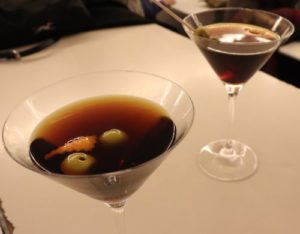

Thank you Northern Spain for inspiring our travel dreams and exceeding our expectations… Cheers until next time 🙂
If you want to read about our time in Southern Spain, check out our blog post here!
The Simply See The World
Southern Spain Travel Guide
Canillas de Aceituno and Málaga
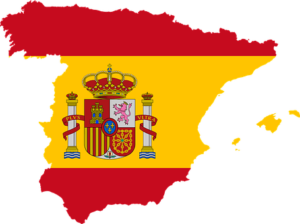
In this travel guide about Spain, we aren’t going to focus on all of the touristy stuff, because, in fact, that was some of our least favorite parts. So you want to see “the real Spain,” the Spain you see in the movies. The olive and almond groves dotting the steep, craggy terrain of deep valleys and towering peaks and the small whitewashed towns with the idyllic café-lined plazas. Leisurely lunches of jamón and wine with long siestas during the heat of the day. Delicious dinner at 10pm with chivo and tempranillo on the menu. After dinner discoteca for drinks and dancing until the sun comes up making the mountain peaks glow.
Sleep in, and do it again.
If this sounds appealing….then consider visiting Canillas de Aceituno in the region of Andalucía, Spain. You’ll get all that and more.
Quick Note: There’s no such thing as “The real Spain”.
Spain is VERY diverse. Each of the 17 autonomous regions of Spain is just as “real” and “authentic” as the others.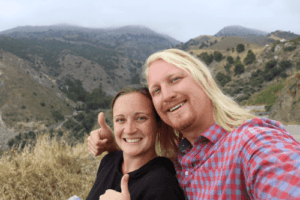
That being said, Andalucía is the region that often comes to mind when most people of Spain.
Andalucía is the southernmost region of Spain and contains Málaga, Seville, Córdoba, Granada, and, of course, this article’s area-of-interest Canillas de Aceituno.
Raychelle and I were lucky enough to spend two months in this region, specifically in the village of Canillas de Aceituno, on a house sitting assignment. In fact, it was the very first assignment of our big around-the-world journey!
Lay of the land
Andalucía stretches from the border with Portugal and the Atlantic Ocean in the west, it borders tiny Gibraltar to the south, and it hugs the Mediterranean Sea on both its south and west. It constitutes a full 17% of Spain’s landmass, or about the size of the US state of Indiana.
Over 8 million people live here, but you wouldn’t know that when you get outside of the cities of the region – much of Andalucía is VERY rural. Like “farmers using horse-drawn carts” rural. Like “you better be at the bus stop on time because there is ONLY one bus each day” type of rural.
Keep reading for a list of the Top 11 Spanish beers!
We fell asleep nightly to the loud, lonely calls of donkeys grazing on the mountainside, and often would walk out to the road to see a shepherd leading his flock of goats past our house to a fresh patch of scrubby grass.
This area is a region of fincas (small farm houses), olive and almond groves, and tiny villages painted uniformly white. It’s as if someone had scattered white grains of rice on a giant brown and green canvas of uneven heights.
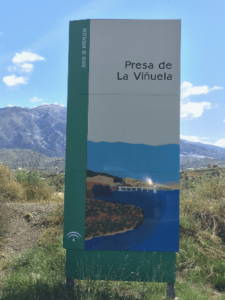
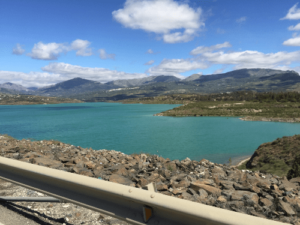
Andalucía is not all countryside, however; it also contains grand cities that highlight Spain’s former colonial wealth. Castles and fortresses are situated on many hilltops offering clues to Spain’s Moorish past.
Moorish, what? Spain was part of a grand Islamic empire from ~700 AD to 1492 AD. These Islamic peoples were collectively known as the Moors.
Wait did you say 1492? That year sounds familiar, doesn’t it?
A Slightly Different Side of Spain
It’s safe to say that this part of Spain is probably different than any place you’ve been, but it will also have a strange familiarity if you’ve traveled to Mexico, Central America, or South America.
Here’s an easy (albeit reductionist) way to think about this area:
Non-coastal or interior Andalucía = small villages (except a few large cities like Granada, Seville, etc) and where a more traditional, slower-paced way of life can be found.
Whereas…
Coastal Andalucía, ESPECIALLY the Costa del Sol = lots of expats (sometimes entire towns of non-Spaniards) and home to a more modernized, globalized, and often faster-paced lifestyle.
The coast has changed A LOT in recent times, beginning with some efforts during the Franco era (a totalitarian leader of Spain from the 1930s to his death in 1975). Since then, it has EXPLODED with development. Now there are high-rise apartment buildings, McDonald’s, malls, and all the trappings of the globalized world.
If you want a McDonald’s, or for that matter even a gas station, you will NOT find it in Canillas de Aceituno.
Most peublas blancas, which are the small villages composed (almost) entirely of white structures and orange-ish roofs, and do not contain chain stores or franchised restaurants.
In many ways, these small towns have preserved a way of life from days gone by and to properly enjoy and appreciate such a place you must SLOW DOWN!
Tranquillo!
You will see are familiar architectural cues: narrow streets (often quite steep and for foot traffic only), buildings with tall vertical façades, church steeples as the tallest structure in the town, courtyards in the center of the houses/buildings, central plazas, and beautiful mosaic tiles.
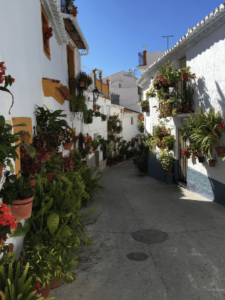 These components of Moorish architecture and design were exported throughout the Spanish empire during Spain’s colonial era (1492 – 1975).
These components of Moorish architecture and design were exported throughout the Spanish empire during Spain’s colonial era (1492 – 1975).
Ok, so enough about the past and the maps…let’s talk travel!
Our time in Canillas de Aceituno, Spain
We flew into Málaga International Airport and drove along the coast and up the mountain to Canillas de Aceituno (a.k.a. Canillas).
It was a misty day, but little did we know this would be the only rain during our stay. For two folks from Indiana to experience a place with ZERO RAIN for two months was VERY different than back home!
We headed east on the A-7, a multilane coastal highway, sandwiched between steep arid mountains and the Mediterranean Sea.
After we left the motorway at the Torre del Mar exit, we found ourselves in Vélez-Málaga. There we saw familiar sights such as McDonald’s and Burger King, as well as new ones like Lidl Supermarket, a German supermarket second only to Aldi in Europe – they both are everywhere.
We started to head up the A-356 towards Canillas de Aceituno, which is one of those classic, idyllic, whitewashed Andalucían villages (aka pueblas blancas) you’ve seen in the movies and in travel brochures.
We stayed in Canillas for FREE for TWO MONTHS!!!
Find out how
YOU can stay for FREE in the travel destinations of your dreams!
Spoiler alert: Canillas de Aceituno is as charming as you would suspect!
The homeowners moved to Canillas to escape the grey skies and rain of England.
It worked!
There are over 320 days of sunshine annually in Canillas. Short, mild winters. Long, hot summers. MUCH less traffic.
Tranquilo!
When we arrived, we observed Canillas from across the steep valley that separated our house from the village. It was a bright and beautiful white pearl situated high on the brownish-green mountainside of Mount La Maroma.
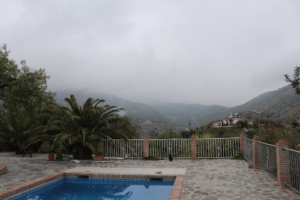 After the homeowners left for their holiday, we were alone as a couple in a new country for the first time on our journey. This would soon be common, but at this point it was new, novel, scary, and exciting.
After the homeowners left for their holiday, we were alone as a couple in a new country for the first time on our journey. This would soon be common, but at this point it was new, novel, scary, and exciting.
During our first weekend in the area, Canillas de Aceituno was having one of its major fiestas.
Party Time!
We naively walked to the village using a trail that we soon discovered to be rather difficult. The trail looked harmless enough, but 3km and the equivalent of roughly 80 flights of stairs later we arrived both sweaty and relieved.
We were ready for a cold beer!
The fiesta takes place the last week of April each year and celebrates the Virgen de la Cabeza, who is carried through town on a litera (yes, one of those things from the movies).
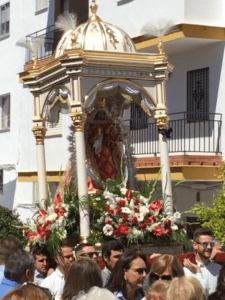
She is accompanied by a full band and a parade of churchgoers following the mass at the Catholic church.
It was a solemn procession and very traditional.
While this is the official reason behind the fiesta, it’s actually all about blood sausage.
Blood sausage? Yes, really.
It’s called morcilla [more – thee – uh] and I’m now a huge fan. Very good, beautiful reddish brown color and grilled to a slight char. Place it between two pieces of bread (pan), coupled with a cold cerveza and – presto! – you’re eating well!
The town had deployed port-a-potties for the event, which had actual porcelain toilet bowls. This would be the first of several juxtapositions between the familiar and the otherworldly (read “holy-cow-that-is-strange/different/weird”) we would witness while in Spain.
Music filled the air and we laughed as the band covered the 1990s one-hit-wonder “Barbie Girl” by Aqua sandwiched within a set of many Spanish songs!
Great festival and an absolute must do if you’re in town in April.
Another festival!
May 15th is the celebration of San Isidro. This festival was housed on the east side of Canillas and a large circus-style tent was erected to house the stage for music and events.
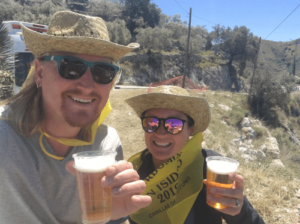
Marching bands, inflatable bounce houses decorated with Disney characters, a curious tractor-like vehicle holding a figure of the Virgin Mary within a complex accompanying tableau, and a long “train” for kids (and big kids) to go for a ride through town.
To our delight, the food and beer was FREE!
Fun in the Sun
The view from Canillas is striking. When we first arrived in late April the Mediterranean was easily viewable most days and what seems to be the faint outlines of the Atlas Mountains across the Sea in Morrocco.
However, towards the end of our stay in late June, the summer heat had introduced a thick haze into the atmosphere. So if you want sea views come between October and April.
We saw the landscape turn from green to brown, and from brown to khaki. And, oh boy, the dust and wind!
Early in our stay, we had days of extreme wind, so windy you couldn’t go outside.
But, no rain. Like, ever. For two months.
The People
Most people in the village are native Spaniards, and many have lived in Canillas their whole lives. There was a finca next to our house where an 86 year-old man named Juan farmed.
As with many other farmers in the area, he lived in the village but had a plot of land with a finca outside of town.
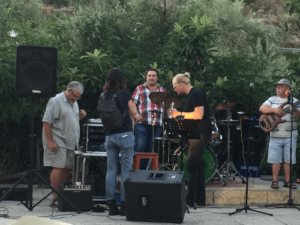
Even though most people are Spanish with local roots, there is a surprising amount of expats here, too – MUCH fewer than on the Costa del Sol, however.
Want great food and pool? La Piscina is a bar next to the municipal pool and is an expat favorite. I was invited to play at an open mic night there, and my three solo songs turned into being essentially the makeshift band leader/guitarist for the entire night.
It was a blast!
Take a Hike!
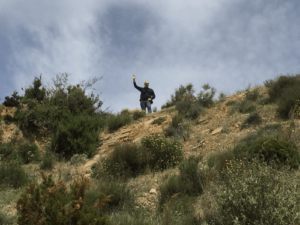
Although there are many interesting hikes in the area, the best one is El Saltillo. The starting point is the village of Canillas, but the actual trailhead is REALLY hard to find.
Go up the hill from restaurant La Maroma and turn right before you get to the goat farm. It’s not marked, unfortunately, so if you start to see and smell goats – turn around, you’ve gone too far.
You’ll know you’re on the right path if you see a small aqueduct ditch along the trail. Also, it’s the only trail; so don’t worry about getting lost. Just walk until you get to the waterfall.
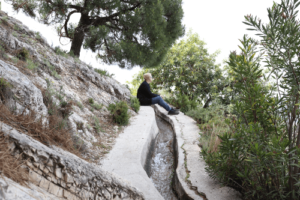
There is a cool suspended walkway made of metal grates and metal cables later in the trail.
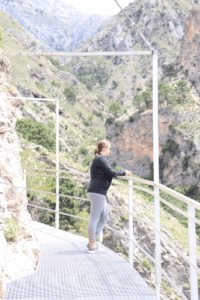
Great views of the mountain, the town of Canillas, and on clear days (basically every day except for summertime) the Mediterranean Sea can be enjoyed along the way.
Don’t turn around early. The end of the trail is the best part.
Be careful of sheer cliffs and your footing on the dirt and rocks. It would be too risky for children on this trail. No guardrails + sheer cliffs = be careful.
When you get back to town we recommend stopping in Bar El Picota for a cerveza and a calamari frito – one of our faves.
For the more experienced hiker, locals recommend summiting Mount La Maroma. It’s about an 8-hour hike and also has a trailhead in Canillas. Modify this hike by starting in nearby Sedella for an easier ascent.
Be sure to pack a LOT of water, especially during the summer.
Eats and Drinks!
Recommended Foods and Dishes in Andalucía:
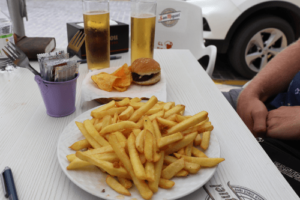 Cocido (pork dish with lots of garlic in a bit of broth, cooked for a loooong time)
Cocido (pork dish with lots of garlic in a bit of broth, cooked for a loooong time)- Papas Fritas (French fries. EVERY Spanish restaurant nails it – they’re better than they should be, great snack with a beer!
- Pan (bread, lots of baguette style breads, all tasty)
- Garbanzos con morcilla (heavy, but delicious)
- Bocadillo de Jamón y Queso – (a really tasty salt-cured, aged ham & cheese sandwich)
- Tortilla España (like a quiche with no pie crust, lots of potatoes, deeeelish!
Best Restaurants and Bars:
- El Picota (Canillas de Aceituno) – True small village plaza bar experience. Old men sit around all day on the nearby town hall steps people watching. Tourists walk and drive through looking both inspired and lost.
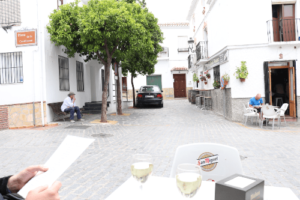
Recommendations at El Picota:
Sit outside to enjoy the entertaining traffic navigating the blind corner – too much fun! Order the calamari frito (a deconstructed sandwich) with a grande sized San Miguel from the tap. This place is CHEAP!
Raychelle and I often had breakfast, lunch, and several drinks each and NEVER paid more than ~ €20 in total!
- Portofino (Nerja) – Great view overlooking Plaza Balcon De Europa and Playa de la Calahonda. Good wine selection, but it’s really about the views and the people watching!
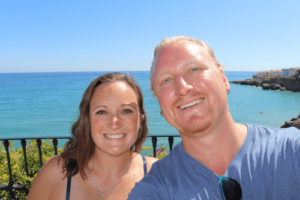
- Restaurante Real Bajo (Vélez-Málaga) – Great Spanish diner. Desert first, beer in the morning, tapas all day – there’s no rules, order what you want when you want.
Top 11 Beers of Spain Ranked:
- Arriaca IPA
- Alhambra
- Estrella Galicia
- Cruzcampo Radler
- Victoria Málaga
- San Miguel
- Cruzcampo Andalucían Pale Ale
- Cruzcampo
- Arriaca Rubia
- San Miguel Manila
- Moritz Barcelona Original
Tasting Notes:
Arriaca IPA is not just a good IPA for a Spanish beer; it’s an IPA that would stand up against most in the US beer scene. A great beer!
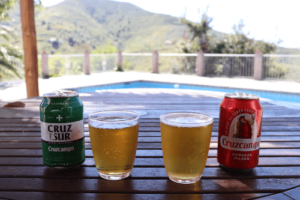 Alhambra is the best light-bodied lager style beer in Spain, period – perfect for hot days and to wash down a jamón sandwich.
Alhambra is the best light-bodied lager style beer in Spain, period – perfect for hot days and to wash down a jamón sandwich.
Estrella Galicia is a bigger bodied, and more flavorful lager. Great accompaniment with dinner.
Want a refreshing beer for after a hike or when you’re REALLY hot? The Cruzcampo Radler will quench your thirst and is an easy drinker; however, one or two and you’re ready for something else.
Attractions and Sights OUTSIDE of Canillas:
Torre del Mar
Visiting the Mediterranean at Torre del Mar was really fun. We walked up and down the coastal walking/biking trail called the Paseo Marítimo and took in the beach views. Tall residential buildings line the beach and the area offers a contrast from the more traditional towns of Andalucía’s interior.
Along the beach you’ll find tables and chairs that are free for the public to enjoy, so we got some supplies from a nearby supermarket and had a picnic!
The Alhambra
The Alhambra is a place many travel guides list as a “must see”. And we agree…to an extent.
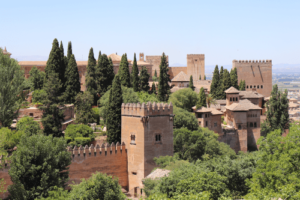 For some visitors, the Alhambra will be absolutely captivating, for most it will be fairly interesting, but for some it is something best avoided.
For some visitors, the Alhambra will be absolutely captivating, for most it will be fairly interesting, but for some it is something best avoided.
Let me explain.
I love history and appreciate architecture, but after about two hours there I was ready to go. I think that finding Moorish history within the context of towns and cities in Andalucía is much more interesting, personally.
But as an architectural marvel (the tile work alone is incredible), cool urban engineering (especially water management), fantastic grounds and garden, and as an important piece of Moorish history it’s worth a visit.
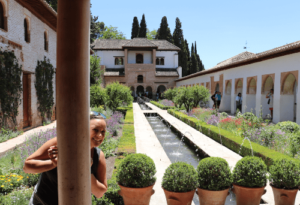
Huge props to the Alhambra grounds team and architectural preservationists – it looks amazing!
Huge jeers to the ticket office – chaos, disorganization, unnecessary queuing, etc – visitors get a runaround and there was no benefit to ordering our tickets online. C’mon! You should be a well-oiled machine since you host TWO MILLION visitors annually…right?
Bottom line: If you’re lukewarm on architectural attractions and are not a history buff then save €30 and don’t devote a day to the Alhambra. But most people will find something they like, and some visitors will be over the moon. Just be sure to pack an extra dose of patience for the ticket office!
Other Attractions: Geology…Rocks!
Geological forces over many thousands of years have created several large caves in the Málaga area. Tesaro Caves (pictured) and the larger Nerja Caves are great places to spend a few hours. Recommendation: Save this for a hot day because the coolness of caves will be a refreshing respite from the heat.
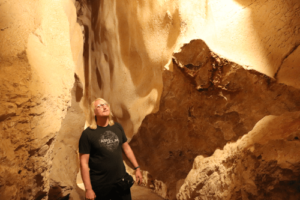
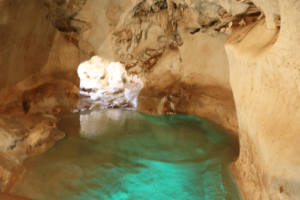
Amongst the Clouds
There are so many charming villages in Andalucía that are both beautiful and high in elevation.
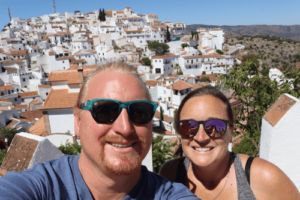
Comares is a little town with unreal views. At only 700m (2300 feet) high, it’s far from being the highest hamlet, but when looking out to the horizon from the central plaza or the ruins of the Moorish castle it appears that you are atop a cloud!
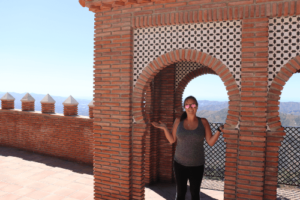
Also, if you fancy a zip line or to do some rock climbing you’ll find it here.
Málaga: A Guide to the City
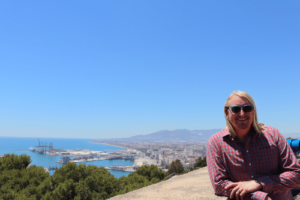
Málaga is a busy, crowded metropolis offering a great diversity of experiences and conveniences unavailable within surrounding villages.
We drove to Málaga and parked underground near Catedral de Málaga, which was less than €10 for the day. We walked along the busy port and saw cars loading on a giant ferry likely bound for the Spanish exclave of Melilla, which is attached to Morocco. Some signs were trilingual: Spanish, English, and Arabic.
We continued on Paseo del Parque and out on the narrow strip of roadway leading to the Málaga Cruise Terminal to see a cool lighthouse called La Farola. Then strolled along the bustling Playa la Malagueta before wandering inland for tapas and beers in the shadow of the historic La Malagueta bullring.
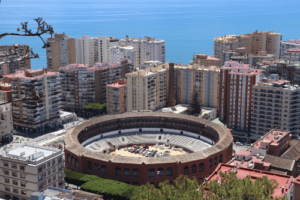
Our thirst quenched, we walked up (way up) to the entrance of Castillo Gibralfaro for a GREAT vista of the city. It is a towering defensive fortress from Málaga’s Moorish past and is worth a look.
Then we continued onto Alcazaba, another Moorish castle, less defensive-focused and more luxurious than Castillo Gibralfaro – it’s kind of a less grandiose version of the Alhambra in Granada.
PRO TIP:
You can see many of the elements of the Alhambra by visiting the Castillo Gibralfaro and Alcazaba. Don’t get me wrong, if you’re a Moorish history buff, architectural aficionado, or a botanical connoisseur you’ll want to go to the Alhambra. If not, save time and money by doing these two attractions instead of the Alhambra.
At the bottom of the hill you’ll see a “recently” unearthed ancient Roman Theater rediscovered in 1951. You’re now back in town and ready for some tapas at nearby Mercado Central de Atarazanas. Raychelle went for a hearty tortilla española with a sangria, while I chose grilled pulpo (octopus), grilled sardines served on a stick, and a beer from the tap.
This is just a taste of Málaga, so be sure to plan at least another day or two if you really want to see all of it.
Málaga is for you if you like…
Málaga is polarizing. Think of it as the Miami of Europe.
If you love the loud, sexy, fashionable, crowded, and the often abrasive chaos of Miami, you’ll like Málaga.
If, like me, you’re not a big fan of Miami, then you’ll enjoy other locales more.
Time for the Beach!
The beaches in Málaga city are busy and loud — and sexy. Málagueños are a good-looking bunch and the weather encourages them to strut their stuff.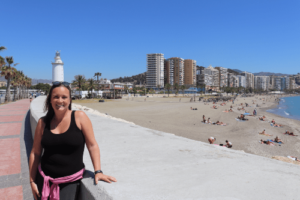
But, you’re over the catwalk-rock-show that is the beach scene in Málaga, and want something more naturally beautiful, quieter, and tranquillo, then check out one of the many small beaches between Málaga and Almería. I recommend Rincón de la Victoria, which is close to Málaga but yet a world away…or, if feeling saucy, pack your birthday suit and head to one of the many nude beaches along the coast.
Wrapping It Up
We at Simply See The World love to travel slow, meet great people, and have awesome experiences without breaking the bank. Canillas de Aceituno ticks all of these boxes and more – for these reasons, we recommend a visit here.
Before setting off on our journey, we did not have this part of Spain on our radar. However, we fell in love with the relaxed vibe, wonderful people, beautiful scenery, and the low cost of living found here.
So don’t limit yourself to Málaga, Granada, or Seville when visiting Andalucía – get off the beaten path to see a more traditional, rural, and intriguing side of Spain! Visit Canillas de Aceituno!

We LOVE reading! When we were doing our research to make our travel dreams come true, books played a big part in gathering information and finding inspiration.
This section on our website is meant to help arm you with some resources to help make your travel dreams a reality.
Vagabonding: An Uncommon Guide to the Art of Long-Term World Travel
is a scant two hundred pages but is the book – the bible – of long-term travel. Potts provides specific details, tips, hacks like what specifically to pack, and whether to travel alone or with a companion; however, he also addresses philosophical ideas of like “striking the right balance between finding yourself and losing yourself on the road”.
If you’re serious about travel – especially long-term travel – is a must read. Raychelle and would argue that outside of the focus of travel, it also provides best practices for enjoying your life…simply.
The book is broken into five parts:
- Vagabonding
- Getting Started
- On The Road
- The Long Run
- Coming Home
Part I, what is Vagabonding?
“Vagabonding–n. (1) The act of leaving behind the orderly world to travel independently for an extended period of time. (2) A privately meaningful manner of travel that emphasizes creativity, adventure, awareness, simplicity, discovery, independence, realism, self-reliance, and the growth of the spirit. (3) A deliberate way of living that makes freedom to travel possible.” – Potts
You can see the influence this book has had on Raychelle and I, and our blog Simply See The World.
After defining the term, Part I takes a look at how Americans live in a way that only allows for “short, frenzied bursts” of travel, and begins to set up themes he discusses in great depth during the rest of the book. “Long term travel doesn’t require a massive ‘bundle of cash’; it requires only that we walk through the world in a more deliberate way.”
Traveling and living “deliberately” allows you to “increase your personal options instead of your personal possessions.” This is what Tim Ferris, in his wide-sweeping book The 4 Hour Work Week, would call “lifestyle design”. But that book is a topic for a whole other blog post (or several!) unto itself! Let’s get back to Vagabonding.
As Raychelle and I see it, life is really all about time, right? Sure you can have more money or more stuff, but who can buy more time? Not even Warren Buffet or Bill Gates. How are you going to spend your short, precious time here on earth?
Part II is all about Getting Started.
Potts goes into details about finances and mindset that he titles “Earn Your Freedom”. Changing your mindset and your behaviors are critical to transitioning from 9-5 life to long-term travel life.
“Vagabonding starts now” says Potts, it “begins the moment you stop making excuses [and] start saving money.”
Here at Simply See The World, we go into detail about pre-trip financial planning, both looking at ideas Potts presents and presenting many from our own experience.
He also explains how there is never a magical “right time” for long term travel, and pushing it into the future for “someday” is just an excuse to not address tough decisions and necessary sacrifices.
Our advice: Get out of debt before you go (if possible), and if you can’t fully dig out, get creative and go anyways. Raychelle and I were not completely out of debt, nor did we have steady work.
Chapter 3 is called “Keep It Simple”, which is especially near and dear to us here at Simply See The World.
“The freedom to go vagabonding has never been determined by income level; it’s found through simplicity – the conscious decision of how to use what income you have.” – Potts
Potts states “America is famous for its unhappy rich people” – are you one of them? Maybe you think, “well I’m not rich”, but ultimately “rich” is a spectrum and all about perspective. How much income do you really need to travel the world? Less than you think. Check out our blog post about Budget Travel
“Travel by its very nature demands simplicity.” – Potts
Potts discusses a “consumer withdraw period” for folks who are deep within Western consumer culture, and most of us are neck-deep when we honestly look at our expenses, possessions, behaviors, and mindset; and he encourages readers to think that every dollar saved allows you more time on the road, and gives you more “vagabonding options.”
“Don’t let…innocuous indulgences…dictate the course of your life by forcing you into ongoing cycles of production and consumption. If you’re already in debt, work your way out of it – and stay out.” – Potts
“Ultimately, you may well discover that vagabonding on the cheap becomes you favorite way to travel, even if given more expensive options.” – Potts
Chapter 4 is called “Learn, and Keep Learning.”
In this chapter Potts encourages those considering long-term travel to prepare and learn much before starting their journey, but to not get fixated on learning everything there is to know but rather learn some and go. Action and attitude matter more than preparedness. However, he does encourage preparedness, especially once you decide to take the plunge.
The pursuit of knowledge needed for rewarding, safe, and low-headache travel (read preparedness) is another reason we started Simply See The World. Our goal is to arm readers with the tools they need to live their travel dreams, no matter what their goals are.
Potts then discusses how to choose where to go, how ambitious (or not) to be with travel itineraries, and how traveling at a slow pace can be a central component to enjoying travel.
He provides sound advice on whether to travel alone or with a partner, what to pack, and dealing with “money issues” abroad. However, he ends by saying that “simple courage is worth far more than detailed logistics, and a confident, positive, ready-to-learn attitude will make up for any travel savvy you lack at the outset.”
Part III: On the Road
Chapter 5 begins Potts discussion about once you have concluded with the planning stage and have set out on your journey. You’re on the road, now what?!?!
“Life on the road, you’ll soon discover, is far less complicated than what you knew back home – yet intriguingly more complex.” – Potts
He cautions that it is essential to “SLOW…DOWN” and to “move deliberately through the world”.
Raychelle and I had to change how we conceptualized time…completely during our fist two months abroad in a small village in Andalusia, Spain.
Taking things slow during the very first part of your journey and to not “see the sights” is something Potts is a big believer of. Furthermore, with the slower pace, and the unfamiliarity of many things (or everything) around you, it is possible to feel “like you’re five years old again.”
“Early on, of course, you’re bound to make travel mistakes.” – Potts
Again, it’s all about attitude. He encourages readers to go slow, make mistakes, grow, laugh at yourself, and learn, and he is absolutely confident you will “look like a tourist dork from time to time.”
Next, he outlines why travelers can become “frustrated” by “playing by the rules of home” when traveling and tells travelers to be in control of their own travel agenda.
He also cautions “habitual avoidance of the ‘sights’ [popular tourist destinations] can be a cliché in itself”.
Don’t be too cool for school; The Louvre is still amazing even though everyone else is doing it!
“Vagabonding is like a pilgrimage without a specific destination or goal – not a quest for answers so much as a celebration of the questions, and embrace of the ambiguous, and an openness to anything that come your way.” – Potts [emphasis is of the author’s own]
One piece of advice that Raychelle and I especially LOVE from Vagabonding is: “If in doubt about what to do in a place, just start walking through your new environment.”
Chapter 5 ends with a valuable and extensive “Tip Sheet” covering Getting Started, Day-to-Day Errands, Accommodations and Facilities, Communication and Packages from Home, Bargaining, Souvenirs, and Taxis and Transportation.
In Chapter 6: “Meet Your Neighbors”, Potts explains that “cultural awareness is often the positive product of rather negative experiences” and that, regardless of how much you prepare, the best training is from “what you’ll learn by accident.”
Potts encourages travelers to pack their sense of humor because “the ability to laugh at yourself” can help you “endure strange new cultural situations.”
He emphasizes that in most travel situations in the majority of the world travelers are met with “warmth and hospitality.”
Finishing out Chapter 6 is a Q & A and a Tip Sheet section including:
Q & A Section:
- How do I go about meeting locals in my travels?
- What are “tourist areas,” and how do they affect my relationship to the locals?
- What about interactions in nontourist areas?
- How do I bridge the “language gap” while traveling?
- How do I respond to offers of hospitality?
- What if I get tired of meeting so many people as I travel?
Tip Sheet Section:
- Culture Shock Overseas
- Cross-Cultural Resources
- Female Vagabonders
- Safety
- Dealing with Men
- Interacting with Local Women
- Resources for Female Travelers
Chapter 7 is titled “Get Into Adventures” and Potts encourages readers to ditch the mindset of adventure being something that can be “itemized in a glossy brochure” and adopt the notion that adventure “finds you” and is a result of when you “open yourself to unpredictability.”
Allow for “getting sidetracked” and to “follow your instincts instead of your plans.”
There are several accounts of his own “adventures” throughout his travels. Spoiler alert, they’re entertaining!
“Adventure is wherever you allow it to find you.” – Potts
Potts cautions readers about sickness and crime as being “the most preventable misadventures on the vagabonding road” before outlining many best practices to avoid both.
Part IV: The Long Run
In Chapter 8, entitled “Keep It Real”, readers are told to abandon prejudices and mindsets from home and to be ultra present in one’s new surroundings, and he also weighs in on the “tourist vs. traveler” dichotomy.
“In this way, ‘seeing’ as you travel is somewhat of a spiritual exercise: a process not of seeking interesting surroundings, but of being continually interested in whatever surrounds you.” – Potts
Potts discusses how one’s political leanings can impact travel experiences before weighing in on what constitutes a “real” travel experience, places that are “spoiled”, and what exactly is a “traditional” culture.
Next, a common issue discussed in my travel books and blogs, Potts offers thoughts on alcohol and drug consumption while on the road and how it impacts one’s experience of travel.
An overall theme, in all chapters of the book, is “Be Creative” and this serves as the title of Chapter 9. He states that “you’ll probably outgrow your original travel motivations” and that the environment you find yourself in, no matter how different from home, will become less novel and even normal soon after your arrival.
Potts discusses the difficult topic of “striking the right balance between finding yourself and losing yourself on the road”.
He offers how to inject spontaneity into travel and how to “prevent travel from getting too predictable” before explaining how the amount of time spent in a given place impacts your experience of it.
We at Simply See The World tout the value of simple pleasures, but agree with Potts that it can be rejuvenating to treat yourself to some luxuries on the road, especially after “roughing it” for a bit. This can also be a great way to shake things up.
“Treat yo self!” – Aziz Ansari as Tom Haverford, Parks and Recreation TV Show
Potts posits that settling into a place for an extended period of time will allow for a different rhythm and variation to one’s journey.
Additionally, he offers that working locally in a new place can offer benefits beyond a few extra dollars, before explaining how volunteering can be a boon to travel.
The chapter concludes by saying, “always challenge yourself to try new things and keep learning.”
Which segues into Chapter 10, “Let Your Spirit Grow”.
“Your decision to enrich your life with time and experience (instead of more ‘things’) will invariably pay spiritual dividends.” – Potts
He warns readers that travel “compels you to discover your spiritual side by simple elimination” in that without stuff and trappings of home you have time and room (and necessity) of being “present” and “come to terms with your raw, true Self”.
Again, he emphasizes that just as adventures are found in the everyday so are “spiritual revelations”.
Part V: Coming Home
Coming home, surprisingly, can be the biggest challenge of travel. He says that many travelers upon being home for a few days will start to “feel a strange sensation of homesickness…for the road.”
Furthermore, he talks about the difficulty of communicating experiences from the road with friends who remained at home, and how talking with friends reveals that you are now a “changed person”.
“Your vagabonding attitude is not something you can turn on and off when it’s convenient. Rather, it’s an ongoing, organic process that can be applied even as you unpack your bags and readjust to home.” – Potts
He emphasizes to travelers not to revert to old ways of overconsumption but rather to “redeploy your simplicity, and make it pay out in free time” and to “earn your freedom all over again.” Additionally, just as spontaneity was part of life on the vagabonding road, he offers that it is good to “allow for unstructured time in your day-to-day home schedule.”
“Explore your hometown as if it were a foreign land, and take an interest in your neighbors as if they were exotic tribesmen.” – Potts
—
Thanks for reading this review of Vagabonding by Rolf Potts. We at Simply See The World can’t express how central the ideas contained within this book are to our mission, and how important these lessons have been to us on our own journey.
If you’re serious about traveling, or for that matter living an enriched life, do yourself a favor and buy this book.
Read it. Live it.
And if you LOVED this book review…..checkout our blog post about 30 Inspirational quotes from “Vagabonding”

